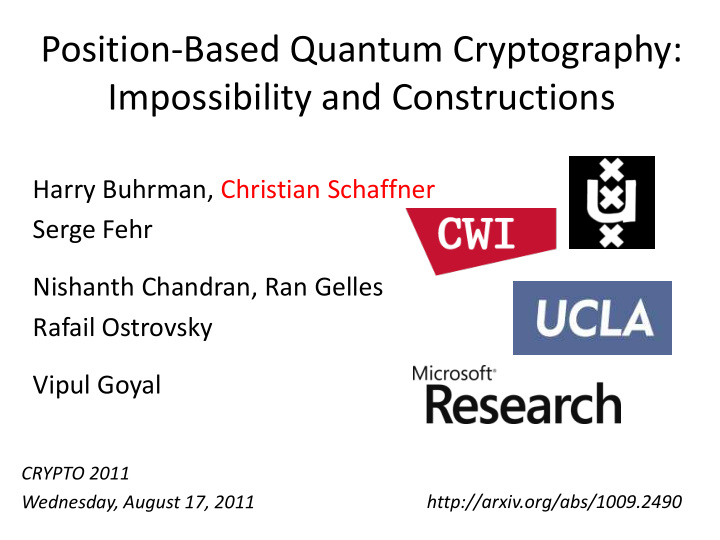



Position-Based Quantum Cryptography: Impossibility and Constructions Harry Buhrman, Christian Schaffner Serge Fehr Nishanth Chandran, Ran Gelles Rafail Ostrovsky Vipul Goyal CRYPTO 2011 http://arxiv.org/abs/1009.2490 Wednesday, August 17, 2011
2 Position-Based Cryptography Typically, cryptographic players use credentials such as secret information authenticated information biometric features can the geographical position of a player be used as its only credential?
3 Position-Based Tasks examples of desirable primitives: position-based secret communication (e.g. between military bases) position-based authentication (i.e. person at specific location can authenticate messages) position-based access control to resources
4 Basic task: Position Verification Verifier1 Prover Verifier2 Prover wants to convince verifiers that she is at a particular fixed position assumptions: communication at speed of light instantaneous computation verifiers can coordinate no coalition of (fake) provers, i.e. not at the claimed position, can convince verifiers
5 Position Verification: Classical Scheme Verifier1 Prover Verifier2 time
Impossibility of Classical Position Verification [Chandran Goyal Moriarty Ostrovsky : CRYPTO ‘09] 6 position verification is classically impossible ! using the same resources as the honest prover, colluding adversaries can reproduce a consistent view computational assumptions do not help
Position-Based Quantum Cryptography [Kent Munro Spiller 03/10, Chandran Fehr Gelles Goyal Ostrovsky, Malaney 10] 7 Verifier1 Prover Verifier2 ? intuitively: security should follow from the quantum no cloning principle
8 Our Results general no-go theorem: Position verification (and position-based encryption, authentication etc.) is impossible also in the quantum setting limited possibility result: Position verification (and also encryption etc.) is possible in the quantum setting assuming that the adversaries hold no pre-shared entanglement.
9 Quick History of Position-Based Q Crypto 2003/2006: [Kent Munro Spiller, HP Labs]: quantum tagging March 2010: [Malaney, arxiv]: quantum scheme for position verification, no formal proof May 2010: [Chandran Fehr Gelles Goyal Ostrovsky, arxiv]: quantum scheme for position verification, rigorous proof, but implicitly assuming no-preshared entanglement Aug 2010 / 2003: [Kent Munro Spiller, arxiv]: insecurity of proposed schemes, new (secure?) schemes Sep 2010: [Lau Lo, arxiv ]: extension of Kent et al.’s attack, proposal of new (secure?) schemes
10 Quick History of Position-Based Q Crypto May 2010: [Chandran Fehr Gelles Goyal Ostrovsky, arxiv]: quantum scheme for position verification, rigorous proof, but implicitly assuming no-preshared entanglement Aug 2010 / 2003: [Kent Munro Spiller, arxiv]: insecurity of proposed schemes, new (secure?) schemes Sep 2010: [Lau Lo, arxiv ]: extension of Kent et al.’s attack, proposal of new (secure?) schemes Sep 2010: [this paper, arxiv]: impossibility of position-based quantum crypto Jan 2011: [Beigi König, arxiv]: improvement of entanglement consumption yesterday‘s Rump Session: the Garden-Hose Model
11 Quantum Teleportation [Bennett Brassard Crépeau Jozsa Peres Wootters 1993] ? [Bell] ? ? does not contradict relativity theory teleported state can only be recovered when the classical information ¾ arrives
Position-Based QC: Teleportation Attack [Kent Munro Spiller 03/10, Lau Lo 10] 12
13 Instantaneous Non-Local Q Computation attack on general position-verification scheme clever way of back-and-forth teleportation, based on ideas by [Vaidman 03] one simultaneous round of communication
14 Impossibility of Position-Based Q Crypto attack works also against multi-round schemes dishonest provers can perfectly simulate the honest prover’s actions
15 Position-Based Quantum Cryptography ? Theorem : success probability of attack is at most 0.85 in the no-preshared entanglement (No-PE) model use (sequential) repetition to amplify gap between honest and dishonest players
16 Position-Based Authentication and QKD verifiers accept message only if sent from prover’s position weak authentication of one-bit messages: if message bit = 0 : perform Position Verification (PV) if message bit = 1 : PV with prob 1-q, send ? otherwise strong authentication by encoding message into balanced repetition-code (0 00…0011…1 , 1 11…1100…0 ) verifiers check statistics of ? and success of PV using authentication scheme, verifiers can also perform position-based quantum key distribution
17 Summary Verifier1 Prover Verifier2 plain model: classically and quantumly impossible to use the prover’s location as his sole credential basic scheme for secure positioning if adversaries have no pre-shared entanglement more advanced schemes allow message authentication and key distribution can be generalized to more dimensions
18 Open Questions Verifier1 Prover Verifier2 no-go theorem vs. secure schemes how much entanglement is required to break the scheme? security in the bounded-quantum-storage model? many interesting connections to entropic uncertainty relations, classical complexity theory (via the Garden-Hose Model), non-local games
Recommend
More recommend